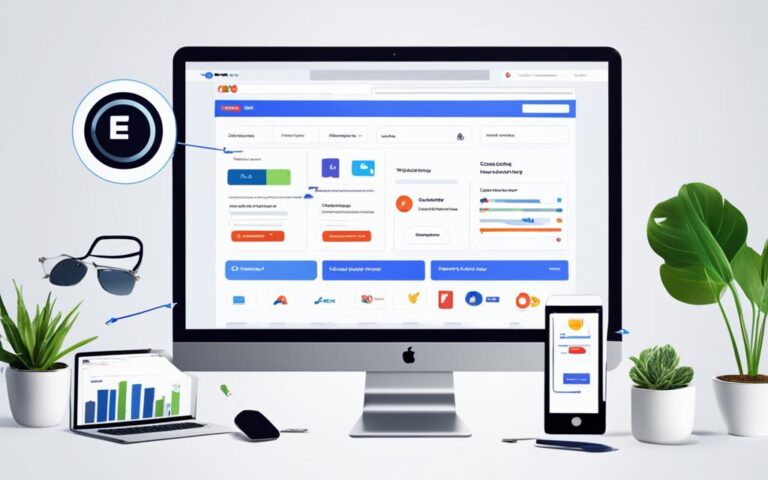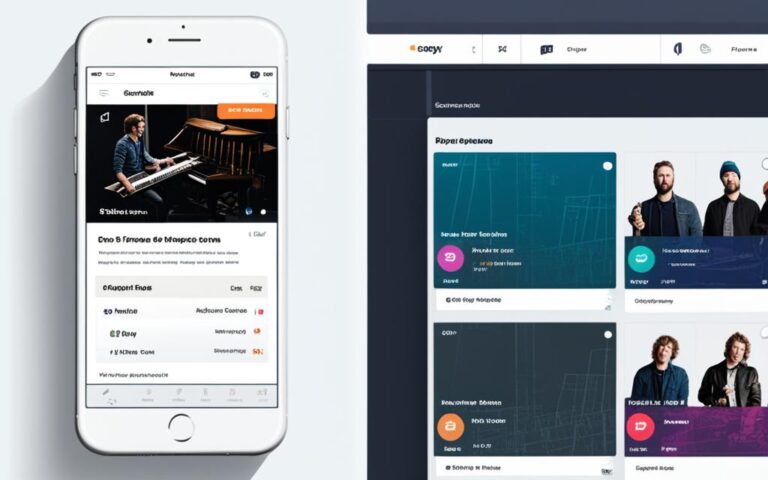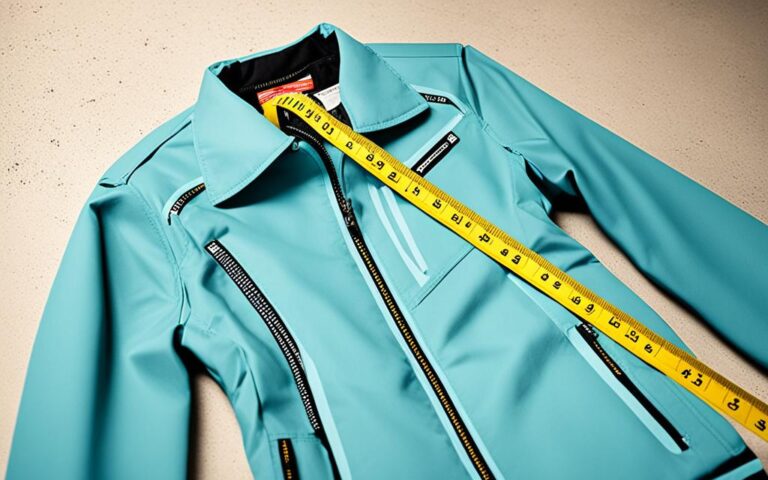Poshmark vs eBay: Which Platform Is Best for You?
Did you know the recommerce market is expected to reach $51 billion by 2023? This is 1.5 times the size of fast fashion by 2028. Choosing the right place to sell is key to your success. In this article, we’ll look at Poshmark and eBay, comparing their differences, audiences, and features.
With 74% of 18 to 29-year-olds valuing sustainable brands, the market is moving towards recommerce. This guide will help you pick the best platform for your needs. Whether you’re new or experienced, knowing which platform to use can boost your earnings. For more information, check out this detailed comparison on Poshmark vs eBay.
Key Takeaways
- Recommerce market projected to reach $51 billion by 2023.
- Poshmark charges a flat fee of $2.29 for sales under $15, while eBay’s fees average around 13%.
- Poshmark primarily serves the US, while eBay has a global reach with 135 million users.
- Buyers aged 18 to 29 are shifting towards sustainable platforms like Poshmark.
- Understanding each platform’s fees and customer service is crucial for effective selling.
Introduction to Selling Platforms
The world of online selling has changed a lot over the years. Now, e-commerce platforms are key for trading goods and services. They let people sell online without the old barriers of traditional retail.
Platforms like Poshmark and eBay show this change well. Poshmark focuses on fashion, while eBay has many categories. It reaches about 167 million users worldwide. These platforms help sellers make money, declutter, or even start a business from home.
Exploring selling platforms, I see how people can make money from their stuff. It’s exciting to think about the new chances for financial growth online. It makes me feel powerful in today’s digital world.
Overview of Poshmark and eBay
In this overview of Poshmark, I find it interesting to note that this platform emerged in 2011, focusing primarily on clothing and fashion items. It quickly gained popularity due to its user-friendly mobile app and vibrant community of over 80 million users. Poshmark’s unique selling point lies in its streamlined selling process, allowing users to list fashion items effortlessly. The flat shipping rate, charged directly to buyers, adds another layer of convenience, particularly for buyers interested in larger bundles.
The overview of eBay shows a broader marketplace established in 1995. With over 132 million active users by 2022, eBay caters to a diverse range of categories, from electronics to collectibles. This generalist approach allows sellers to tap into various markets. eBay offers listings for the first 250 free each month, promoting accessibility for new sellers. Nonetheless, the platform’s complex fee structure can be a challenge, with percentages varying significantly depending on categories.
In this platform comparison, it’s crucial to recognize how these foundational differences shape the user experience. Poshmark’s focus on fashion fosters a younger audience, especially women aged 18-35, while eBay appeals to a more diverse user base seeking varied products. Both platforms have their merits, yet Poshmark excels in simplicity and transparency, while eBay shines in its extensive market reach and variety.
Buyer Demography and Target Audience
Knowing who buys on Poshmark and eBay is key for sellers. eBay draws many, from collectors to bargain hunters, with its wide range of secondhand items. It’s especially popular with users aged 25-34, reaching a broad age range. Every year, up to 200 million active users look for deals on various items.
Poshmark, on the other hand, focuses more on fashion and luxury. About 80% of its users are female, and 30% are from Generation Z. This shows that young, fashion-savvy buyers are the main audience for Poshmark. Users spend an average of 27 minutes on the site, showing their deep interest in fashion.

Knowing your audience well can greatly boost your sales. Poshmark sellers should aim for younger buyers, while eBay sellers can appeal to a wider range of interests. By matching your products with the right audience, you can increase your sales.
For more insights on the differences between Poshmark and eBay, check out this comparison of the two platforms.
Poshmark vs eBay: Key Differences
When comparing Poshmark and eBay, one key difference is their focus. Poshmark is all about fashion and lifestyle, with a community that loves to connect. eBay, however, offers a wide range of products, attracting a broader audience with options like auctions.
Each platform has its own way of selling. Poshmark makes it easy and social, with features like sharing and following. eBay, on the other hand, gives sellers more choices, like fixed prices or auctions. This lets sellers tailor their sales to fit their items and audience.
The fees for selling on these platforms also differ. Poshmark charges a flat $2.29 for sales under $15 and 20% for more. eBay’s fees are more complex, with a 10% sales fee plus a 3% PayPal charge, totaling 13%. This can impact how sellers plan their sales.
Payment and shipping processes are also different. Poshmark pays sellers right away, making sales smooth. eBay sellers have to wait for buyers to pay. Shipping is simpler on Poshmark for items under 5lbs, but eBay offers more choices.
Knowing the differences between Poshmark and eBay is crucial for sellers. Choosing the right platform helps sellers reach their audience better and succeed in online sales.
Listing and Selling Limits on Each Platform
When selling on Poshmark and eBay, knowing the listing limits is key. Poshmark lets me list items for free, without limits. This means I can show off as many products as I want without extra costs.
Poshmark’s no-fee policy gives me freedom. I can keep updating my stock without worrying about listing fees.
On the other hand, eBay has a different setup. It offers 50 free listings a month. But, selling a lot can hit a wall here. eBay charges extra for listings beyond that.
This fee can cut into my profits. So, I have to pick my listings carefully. I aim to make the most of my free slots.
Poshmark’s flexibility is great for fashion sellers. It has 200 million listings, showing its active community. eBay, with 1.5 billion listings, covers more categories like electronics and collectibles.
Knowing these differences helps me plan better for each platform. I use their strengths to my advantage in listing and selling.
Fees Structure: Understanding Costs
Knowing the costs of selling online is key to making money. Poshmark and eBay have different fee structures. This affects how much I can earn from my sales. By understanding these fees, I can choose the best platform for me.
Poshmark Fees Breakdown
Poshmark’s fees are easy to understand. For items sold over $15, they take a 20% commission. If I sell something for $15 or less, there’s a flat fee of $2.95. This helps me set prices that keep my profits high.
eBay Fees Explained
eBay’s fees are a bit more complicated. They charge about 12.55% as a final value fee, plus $0.30 per order. These fees change based on the item category. Knowing this lets me price my items wisely, avoiding losses.

Shipping Policies and Options
Understanding shipping policies is key when selling online. Poshmark makes it simple with a flat-rate shipping model. It costs $7.11 for items under 5 lbs, including prepaid labels. This makes it easy for sellers to wrap up a sale.
On the other hand, eBay offers many shipping options. Sellers can set their own rates or offer free shipping to draw in buyers. eBay also supports returns within 180 days through PayPal, boosting buyer trust. With 200 million users a year, it’s important to have shipping policies that fit different customer needs.
Shipping costs are a big part of pricing on both platforms. Poshmark’s fixed fee helps sellers set prices easily. eBay’s options let sellers adjust costs based on item value and distance. Knowing about shipping policies can really help sellers boost sales and improve customer satisfaction.
Ease of Use: Which Platform is Simpler?
When we look at Poshmark and eBay, it’s clear which one is easier to use. Poshmark is known for its simple design. It makes it easy for anyone to list items quickly. You can upload photos, write descriptions, and set prices fast.
Poshmark also lets you list items for free, which helps sellers get started fast. This makes it easy to sell and engage with customers.
On the other hand, eBay has more features but is more complex. Listing items on eBay requires a lot of details. This can be hard for beginners.
Even though eBay offers 50 free listings a month, its setup can be overwhelming. It’s not as simple as Poshmark.
Both platforms have their own strengths and weaknesses. eBay has more users, over 132 million, but Poshmark focuses on secondhand fashion with 80 million users.
If you want something easy to use, Poshmark is the better choice. You can find more about Poshmark vs eBay usability to see which fits your style better.
Customer Service: Support and Resources
Effective customer service is key in online selling. Poshmark uses email support, but users often find it slow. This can hurt sales and make buyers unhappy.
On the other hand, eBay has a better setup. It has a huge library of resources for sellers. If you still need help, eBay’s phone support is there for you.
The quality of customer service really matters. Quick help is crucial for sellers dealing with online selling’s challenges. Think about the customer service when choosing a platform.
Conclusion
As we finish comparing Poshmark vs eBay, think about what’s most important to you. Both platforms have their own strengths. Poshmark is easy to use and has a close-knit community. eBay, on the other hand, reaches a global audience and sells many different products.
Poshmark is great if you want to sell fashion easily. It charges a flat 20% commission on sales over $15. It’s perfect for those selling fashion and keeping their inventory small. eBay, with its lower fees and more listing options, is better for a wide range of products.
Choosing the right platform depends on your selling goals. I suggest looking into each platform’s details and fees that could impact your earnings. By carefully considering these, you’ll make a choice that fits your needs.
FAQ
What are the main differences between Poshmark and eBay?
Poshmark is all about fashion and lifestyle items. eBay, on the other hand, sells a wide range of products. This affects who uses each platform and how sellers market their items.
Which platform has a simpler listing process?
Poshmark is easy to use, especially for new sellers. It has a simple app for listing items. eBay, with its many features, can be harder to learn.
How do the fees work on Poshmark and eBay?
Poshmark takes 20% of sales over and .95 for sales under that. eBay charges about 13% in fees plus
FAQ
What are the main differences between Poshmark and eBay?
Poshmark is all about fashion and lifestyle items. eBay, on the other hand, sells a wide range of products. This affects who uses each platform and how sellers market their items.
Which platform has a simpler listing process?
Poshmark is easy to use, especially for new sellers. It has a simple app for listing items. eBay, with its many features, can be harder to learn.
How do the fees work on Poshmark and eBay?
Poshmark takes 20% of sales over $15 and $2.95 for sales under that. eBay charges about 13% in fees plus $0.30 per order. Fees can change based on what you sell.
How is shipping handled on each platform?
Poshmark makes shipping easy with flat rates and prepaid labels. eBay offers more shipping options, including international, which might take more work but gives sellers more choices.
Which platform targets a younger audience?
Poshmark is popular with young women who love fashion. eBay appeals to a wider range of people, including collectors and bargain hunters of all ages.
Are there any limitations on listings for each platform?
Poshmark lets you list for free and without limit. eBay gives 50 free listings a month. After that, you pay for each listing.
How does the customer service differ between Poshmark and eBay?
Poshmark uses email for support. eBay has a big library of tutorials and FAQs to help sellers.
Which platform is better for selling collectibles?
eBay is great for collectibles because it has a big audience and lots of categories. It’s perfect for finding specific items.
Can I use either platform to start a small business?
Yes, both platforms are good for starting a small business. Poshmark is best for fashion, while eBay has more categories for different products.
Are there different strategies for selling on Poshmark versus eBay?
Yes, there are. Poshmark is all about social selling. eBay’s auction and fixed-price formats need different strategies to draw buyers. Knowing these can help you sell better.
.30 per order. Fees can change based on what you sell.
How is shipping handled on each platform?
Poshmark makes shipping easy with flat rates and prepaid labels. eBay offers more shipping options, including international, which might take more work but gives sellers more choices.
Which platform targets a younger audience?
Poshmark is popular with young women who love fashion. eBay appeals to a wider range of people, including collectors and bargain hunters of all ages.
Are there any limitations on listings for each platform?
Poshmark lets you list for free and without limit. eBay gives 50 free listings a month. After that, you pay for each listing.
How does the customer service differ between Poshmark and eBay?
Poshmark uses email for support. eBay has a big library of tutorials and FAQs to help sellers.
Which platform is better for selling collectibles?
eBay is great for collectibles because it has a big audience and lots of categories. It’s perfect for finding specific items.
Can I use either platform to start a small business?
Yes, both platforms are good for starting a small business. Poshmark is best for fashion, while eBay has more categories for different products.
Are there different strategies for selling on Poshmark versus eBay?
Yes, there are. Poshmark is all about social selling. eBay’s auction and fixed-price formats need different strategies to draw buyers. Knowing these can help you sell better.







